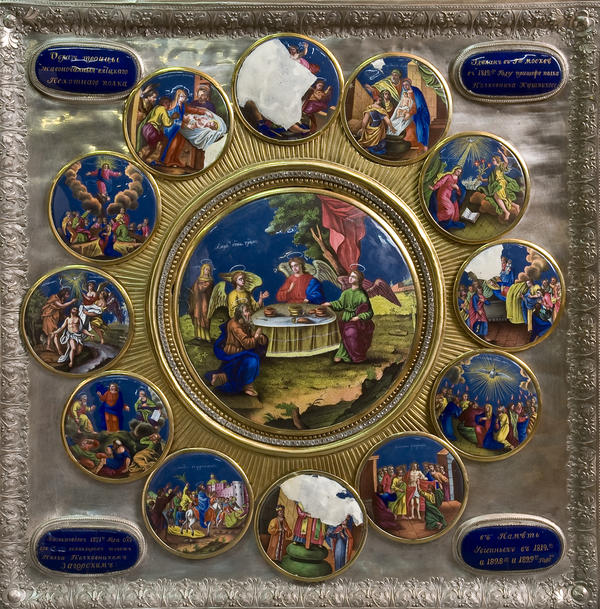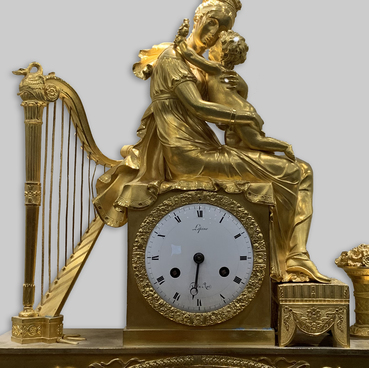The icon is a composition consisting of seventeen plaques of painted enamel. Images were applied on the copper supports fastened to the silver-mounted wooden board. In the centre of the composition there is a large plaque of the Old Testament Trinity set into a narrow and smooth silver frame with gilding. Its edges are outlined with transparent cut glass.
The central plaque is encircled with round miniature insets with the images of Orthodox festivals. All four corners are adorned with oval plaques with dark blue background and golden inscriptions. From the icon mid section emanate chased direct rays, while the edges of the silver frame are ornamented with inlays in floral motifs.
The Old Testament Trinity icon belonged to the Vyatka infantry regiment manned in 1700. This regular unit took part in various military operations: as part of the 3rd Western Army, the regiment was fighting at Volkovysk in 1812, while in 1813-1814 it fought near Leipzig, Bautzen and Vitry. Besides, it actively participated in punitive expeditions to suppress civilian riots. The regiment distinguished itself in the seizure of Kolberg during the peasant war led by Pugachev. In 1833, the Vyatka unit was disbanded and assigned to the Suzdal infantry regiment.
Our Old Testament Trinity and Festival tier icon was created in the period from 1812 to 1831 and is a very interesting element of Russian church jewelry art called a plaque. The plaque was made as follows: several coats of enamel were applied on a convex copper plate. Then the plate was annealed in a kiln at a temperature up to 800°С, thereafter the enamel fused together with the metal and an even surface was formed.
The next phase is painting made with heat-resistant paints. After each application of a drawing the plate was annealed in the kiln. For this reason, in the beginning of the process high-melting point paints were used, while in the end light-melting point ones. On average, in creating a multi-coloured icon on enamel the plate was annealed 4-7 times.
When making the Old Testament Trinity and Festival tier icon presented in the show-case the master used several various techniques: embossing, chasing, gilding and painting. The plaque is kept in the collection of the Museum of the Patriotic War of 1812 to commemorate the disbanded Vyatka infantry regiment which took part in the Russian-French war.
The central plaque is encircled with round miniature insets with the images of Orthodox festivals. All four corners are adorned with oval plaques with dark blue background and golden inscriptions. From the icon mid section emanate chased direct rays, while the edges of the silver frame are ornamented with inlays in floral motifs.
The Old Testament Trinity icon belonged to the Vyatka infantry regiment manned in 1700. This regular unit took part in various military operations: as part of the 3rd Western Army, the regiment was fighting at Volkovysk in 1812, while in 1813-1814 it fought near Leipzig, Bautzen and Vitry. Besides, it actively participated in punitive expeditions to suppress civilian riots. The regiment distinguished itself in the seizure of Kolberg during the peasant war led by Pugachev. In 1833, the Vyatka unit was disbanded and assigned to the Suzdal infantry regiment.
Our Old Testament Trinity and Festival tier icon was created in the period from 1812 to 1831 and is a very interesting element of Russian church jewelry art called a plaque. The plaque was made as follows: several coats of enamel were applied on a convex copper plate. Then the plate was annealed in a kiln at a temperature up to 800°С, thereafter the enamel fused together with the metal and an even surface was formed.
The next phase is painting made with heat-resistant paints. After each application of a drawing the plate was annealed in the kiln. For this reason, in the beginning of the process high-melting point paints were used, while in the end light-melting point ones. On average, in creating a multi-coloured icon on enamel the plate was annealed 4-7 times.
When making the Old Testament Trinity and Festival tier icon presented in the show-case the master used several various techniques: embossing, chasing, gilding and painting. The plaque is kept in the collection of the Museum of the Patriotic War of 1812 to commemorate the disbanded Vyatka infantry regiment which took part in the Russian-French war.


